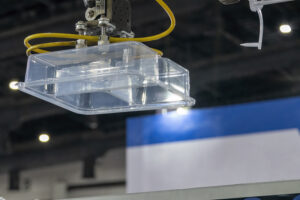The telecommunication industry is a massive economic sector worth tens of billions of dollars. This space encompasses everything from the compact mobile phone in your pocket to massive cellular towers and even communications satellites working in space. Over the last two decades, we’ve seen substantial changes in this domain, much like we’ve seen major shifts in other sectors. These changes have ushered in fresh innovation and substantial improvements to how telecommunication companies do business.
Some of those changes have been fundamental, such as the transition to smartphones and the widespread embrace of fiber-optic communications. Other changes have been smaller and more subtle, still playing a fundamental, even critical, role in enabling further miniaturization for innovative projects. Chief among these changes has been the increasing embrace of thermoplastics for use within telecommunications equipment.
At Reliant Plastics, we’re proud to play an important part in enabling and furthering this evolution by offering high-quality injection molded parts suitable for many applications. Let’s consider why plastics have such an important role to play in this space and examine a few of the most common ways plastics are used here.
Benefits of Thermoplastic Injection Molding for the Telecommunications Industry
Many manufacturers working on the creation of telecom equipment pivoted toward embracing plastic injection molding. There are several reasons for this. Foremost among them is the simple fact that many types of plastics are already in use within this space. Plastics have many important material properties that make them especially suited to applications within telecommunications engineering spaces.
Using an experienced plastics manufacturer lets telecoms and their suppliers access a reliable supply of everything from individual components to larger products and assemblies. All must exhibit some specific properties necessary for proper fit and function, including:
- High tensile strength.
- Excellent resistance to heat.
- Durability, including higher-than-average resistance to impacts, material fatigue, and chemical exposures.
- Rigidity or flexibility, depending on the needs of the end product.
- Low cost, compared to metal parts and components.
- Waterproof properties.
Injection molding can be used to manufacture many kinds of parts for communications equipment. With this process, the benefits listed above can apply to virtually any product within the telecom industry. These products include everything from phones to computers to keyboards and even fiber-optic cabling.
Fiber Optics and the Future of Telecommunication: How Plastics Help Pave the Way
Fiber optics offer an especially apt case study for why telecom injection molding is growing as a market niche as the industry continues to evolve. Stronger performance necessitates more robust products and infrastructure. Fiber-optic networks are the future of connectivity, and they’re already well established in many parts of the country. Fiber optics offer much faster internet speeds than the traditional coaxial cable networks.
The success of these networks relies upon more than just the actual fiber-optic cabling. At many points in the network, there is a need for equipment to help route and control these signals. That means an array of adapters, attachments, routers, modems, switches, and other small plastic parts. All these elements must work well together, so why is plastic the right choice? Its ability to hit tight tolerances and achieve consistent results for small components. With the ability to reliably reproduce even small parts to ensure a snug fit between cables, we can help build the next generation of telecommunication systems.
Other Applications for Injection Molding in Telecommunications Equipment
Fiber optics may be vital to improving the telecommunication services of today and tomorrow, but they are just one element of a much larger industry. From wireless carriers to traditional landline phones, you’ll find plastics almost everywhere you look. Some of the other applications you’ll encounter include:
- Components for phone handsets, such as housings, buttons, receivers, and others.
- Electrical insulators.
- Plugs and connectors for terminating or connecting cabling.
- Signal router housings.
- Antenna housings.
- Enclosures to protect terminals and routers.
- Mounting brackets and connectors.
- Vibration dampers, and more.
There’s another important benefit to using injection molded plastic for these parts, too. Many kinds of telecom equipment use color coding to distinguish between different types of networks or connectors. With a wide range of colors and finishes available, it is simpler to create plastic parts coded to the correct colors for effective networking.
Why Choose Reliant Plastics as a Telecom Injection Molding Plastic Manufacturer
At Reliant Plastics, we are proud to be a versatile injection molding company serving a diverse range of industries, from aerospace to automotive to consumer products. Widely trusted for our build-to-order capabilities, manufacturing capacities, and quality control track record, we’re well suited to serve the telecommunications industry, too.
Within this space, we have made a name for ourselves by offering thermoplastic components that meet high expectations for both aesthetics and function. We can match parts to suit your specifications exactly, including color, fit, form, durability, and overall function. With our unbeatable quality standards, we have become a vital step in the supply chain for many telecom manufacturers.
Contact Reliant today to find out more about our capabilities.




